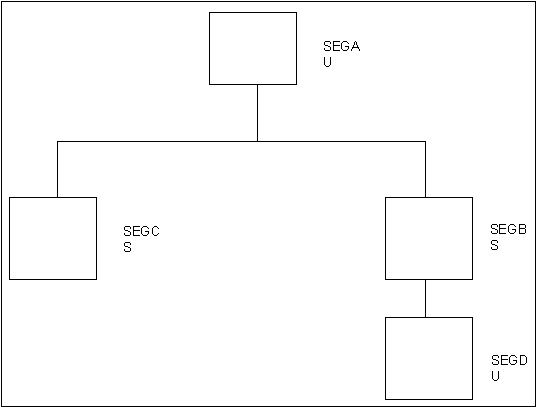Effects of Screening Conditions on Retrieval
If a record in a segment fails a record selection (IF)
test, the corresponding records in descendant segments are not retrieved.
To increase I/O efficiency, place a record selection test at
a higher level in the file structure. This restricts the number
of records that have to be tested.
Example: Using Selection Criteria on Parent Segments
Suppose
this request is entered against the structure EMPSS01 (the corresponding Master
File is EMPFULL).
TABLE FILE EMPFULL
COUNT EMP_ID AS 'NUMBER OF EMPLOYEES'
BY OFFICE_CODE AS 'OFFICE CODE'
IF DEPT_NAME EQ 'PERSONNEL'
END
The output is:
OFFICE CODE NUMBER OF EMPLOYEES
----------- -------------------
002 4
Every time a record
in segment DEPT has a value in the DEPT_NAME field not equal to PERSONNEL,
the corresponding records in descendant segments EMPLOYEE and OFFICE are
ignored, and the next record in segment DEPT is retrieved. In addition,
when IF criteria on a lower segment fail, the row is removed from
the internal matrix.
Example: Using an IF Test on a Descendant Segment
Assume a subtree has four segments:
- DEPT contains department
IDs and information.
- EMPLOYEE contains employee names and IDs.
- EMPOSIT contains the positions that the employee has held.
- JOB contains a list of jobs offered by the company.
The following example illustrates how
to list all employees who are programmer/analysts:
TABLE FILE EMPFULL
PRINT TITLE AS 'TITLE'
BY DEPT_NAME AS 'DEPARTMENT'
BY EMP_LAST_NAME AS 'LAST NAME' IN 25
BY EMP_FIRST_NAME AS 'FIRST NAME'
IF TITLE IS 'PROGRAMMER/ANALYST'
END
The output is:
DEPARTMENT LAST NAME FIRST NAME TITLE
---------- --------- ---------- -----
INTERNAL SOFTWARE DOUGH JANE PROGRAMMER/ANALYST
GALLWAY JAMES PROGRAMMER/ANALYST
GRANGER PERCY PROGRAMMER/ANALYST
HEAROWITZ VLADIMIR PROGRAMMER/ANALYST
JENSEN JULIE PROGRAMMER/ANALYST
O'HEARN KATHERINE PROGRAMMER/ANALYSTFor
this request with only one IF test, FOCUS retrieves each DEPT record,
each EMPLOYEE record for a given DEPT, each EMPOSIT record for a
given EMPLOYEE record, and the JOB record connected to each EMPOSIT.
After retrieval, FOCUS determines whether to print the record from
the value of the TITLE field.
Example: Using Multiple IF Tests to Reduce I/O
The following example produces the same
output as the example in Using an IF Test on a Descendant Segment. In this company, only
the Internal Software department has programmer/analysts working
for it. Therefore, adding an additional IF test on the parent segment
(DEPT) reduces the number of descendant segments retrieved:
TABLE FILE EMPFULL
PRINT TITLE AS 'TITLE'
BY DEPT_NAME AS 'DEPARTMENT'
BY EMP_LAST_NAME AS 'LAST NAME' IN 25
BY EMP_FIRST_NAME AS 'FIRST NAME'
IF DEPT_NAME IS 'INTERNAL SOFTWARE'
IF TITLE IS 'PROGRAMMER/ANALYST'
END
Now records
are only retrieved and tested when the DEPT_NAME field equals the
value INTERNAL SOFTWARE.
xRestricting the Number of Records Retrieved
Another method used to increase efficiency is to restrict
the number of records retrieved. You can always limit the number
of records retrieved from the IDMS data source, and/or the number
of records that FOCUS accepts, with READLIMIT and RECORDLIMIT tests.
Add one or both of these IF criteria to your request.
x
Syntax: How to Place a Limit on Records Retrieved
IF READLIMIT IS number
IF RECORDLIMIT IS number
Tip: These
criteria can be assigned to your password as part of file security
through the FOCUS DBA facility.
A third method that increases efficiency
is file inversion. See File Inversion for
more information.
xScreening Conditions With Unique Segments
If a record in a unique segment
fails a selection test, its parent is rejected and the next record
of the parent segment is retrieved. For example, in the following
figure if a record in non-unique segment C fails an IF test, the
next record in segment C is retrieved. Only if all C records for
a given A fail the test is the A record rejected. When a record
in unique segment D fails a test, the parent B record is rejected
and the next record in segment B is retrieved. When a record in
the entry A segment fails a test, FOCUS retrieves the next A record,
even if the entry segment is defined as unique:

